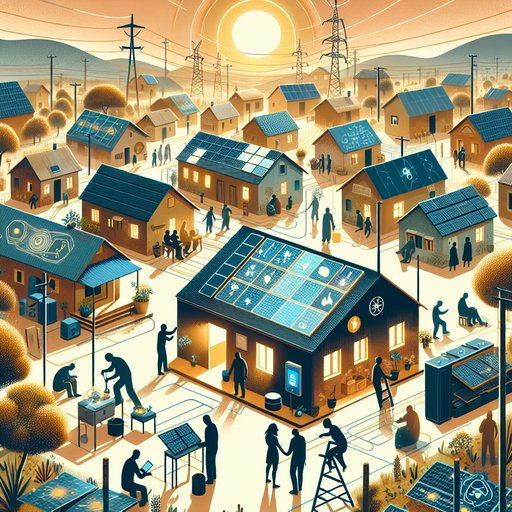
Expanding clean energy access to underserved communities is no longer a distant ambition; it is a practical pathway unfolding today through microgrids, pay‑as‑you‑go solar, and community energy projects. These approaches have emerged as powerful complements to national grids, which often struggle to reach remote or low-income areas with affordable, reliable power. Rapid declines in the cost of solar, batteries, and digital technologies, combined with innovations in finance and community ownership, are turning energy access into a viable, scalable service. By matching technology to local needs and aligning incentives for consumers, entrepreneurs, and utilities, these models deliver electricity that is cleaner, more resilient, and more inclusive. Their success is reshaping the conversation from charity to choice, investment, and long-term economic development.
Bringing clean energy to underserved communities is central to solving global energy and climate challenges because energy poverty and climate vulnerability frequently overlap. Hundreds of millions of people still lack electricity, while many more experience weak, unreliable service that stalls education, healthcare, and livelihoods. At the same time, climate impacts such as extreme heat and storms are increasing the need for resilient power where infrastructure is most fragile. Solutions that can scale quickly, operate independently when needed, and run on renewables address both development and decarbonization goals.
This is where microgrids, pay‑as‑you‑go solar, and community energy projects prove uniquely relevant. Modern microgrids combine local generation, storage, and control systems to deliver reliable electricity to villages, islands, peri‑urban neighborhoods, and critical facilities. Because they can “island” from the main grid, they keep power flowing through outages and disasters, and they can connect later when the main grid arrives. Solar‑plus‑battery microgrids reduce diesel dependence, cut operating costs, and contain pollution, while smart meters and remote monitoring improve uptime and revenue collection.
Advances in controllers, lithium‑iron‑phosphate batteries, and modular designs have lowered life‑cycle costs and made microgrids faster to deploy. The result is a utility‑grade service tailored to local demand, rather than a one‑size‑fits‑all grid extension. Business models are evolving to make microgrids financially sustainable by aligning supply with productive use of energy. Developers often anchor projects with steady loads such as telecom towers, clinics, or water systems, then expand service to households and small enterprises.
Encouraging productive uses like milling, cold storage, irrigation, and e‑mobility charging increases daytime demand and improves revenue stability. Tariffs are designed to reflect cost while protecting low‑income customers through lifeline rates or connection subsidies. When policy allows interconnection, microgrids can eventually sell surplus power or serve as distributed resources that strengthen the larger grid. Pay‑as‑you‑go solar has transformed how households and microbusinesses acquire electricity by turning a capital purchase into an affordable service.
Enabled by mobile money, smart metering, and remote disconnection, customers pay small daily or weekly amounts to use a solar home system, gaining lighting, phone charging, and efficient appliances without taking on unaffordable debt. Over time, payments build asset ownership and credit histories that can unlock larger systems or income‑generating devices like solar fridges and sewing machines. Companies use usage data to tailor products and maintenance, reducing defaults and downtime. Because systems are modular, service can scale from a few lights to higher tiers of access as incomes and needs grow.
Community energy projects diversify ownership and decision‑making, which can deepen trust and ensure that benefits stay local. Cooperatives, neighborhood associations, and municipal entities have organized to finance and operate shared solar, micro‑hydro, and wind assets, with revenue reinvested in public services or reduced bills. In regions with strong rivers but limited road access, community‑managed micro‑hydro has provided decades of reliable power with local operators trained to maintain turbines and distribution lines. Shared solar gardens allow renters and low‑income households to subscribe to generation located off‑site, overcoming barriers like unsuitable roofs or high upfront costs.
When communities co‑design projects, they tend to optimize for reliability and affordability rather than short‑term profit alone. Finance and policy are the levers that turn pilots into systems. Results‑based financing, concessional loans, and guarantees can de‑risk early projects and crowd in private capital, while clear mini‑grid regulations give developers confidence to invest. Import duty exemptions for renewable components, standardized interconnection rules, and performance‑based subsidies help align costs with public benefits.
Interoperable smart meters, open data standards, and strong consumer protection frameworks reduce vendor lock‑in and improve service quality. Where appropriate, measured emissions reductions and resilience benefits can attract climate finance, provided that accounting is rigorous and communities share in the value. The common thread is predictable rules that reward reliable service, not just installed capacity. These access models work best when they meet social priorities alongside technical targets.
Training local technicians and entrepreneurs creates jobs and builds the maintenance ecosystem that keeps systems running years after ribbon‑cuttings. Programs that intentionally include women in sales, service, and leadership roles tend to reach more households and improve repayment rates, while bringing new perspectives to product design. Clean energy access also unlocks health benefits by replacing kerosene lamps and diesel generators, improving indoor air and reducing noise. Coupling electricity with efficient appliances and clean cooking helps households capture the full value of energy, turning kilowatt‑hours into better livelihoods.
Resilience and integration will define the next chapter for inclusive energy. As national grids expand, well‑designed microgrids can interconnect and trade power, avoiding stranded assets and enhancing stability during peak demand or emergencies. Pay‑as‑you‑go providers are broadening offerings to include appliance financing, agricultural services, and e‑waste take‑back programs to manage batteries responsibly. Community projects are experimenting with local energy markets and demand response, coordinating consumption around solar output and lowering costs.
Data transparency across these models helps planners target subsidies where they matter most and measure progress toward universal access. Scaling what works means matching solutions to context rather than promoting a single technology. Dense peri‑urban neighborhoods may benefit from grid upgrades complemented by rooftop solar and storage, while remote communities lean on microgrids or pay‑as‑you‑go systems that can be installed within weeks. In every case, durable access depends on operations, customer service, and fair tariffs as much as on panels and batteries.
With the right policies, finance, and community leadership, these innovations can deliver reliable, clean power where it has been most elusive. The payoff is broad: resilient communities, new livelihoods, and a faster, fairer global energy transition.







































